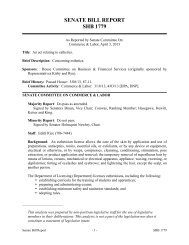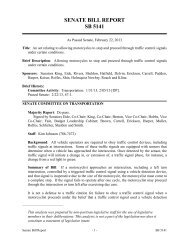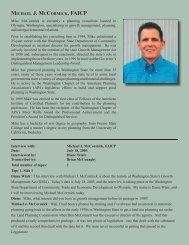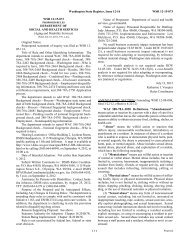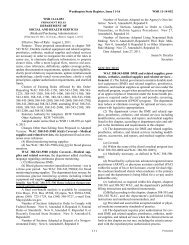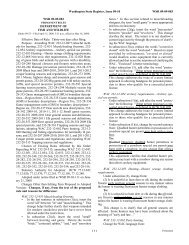Proposed
Proposed
Proposed
You also want an ePaper? Increase the reach of your titles
YUMPU automatically turns print PDFs into web optimized ePapers that Google loves.
(C) Any plumbing work regulated under chapter 18.106<br />
RCW.<br />
(l) Equipment repair (07E): Servicing, maintaining,<br />
repairing, or replacing utilization equipment.<br />
See RCW 19.28.095 for the equipment repair scope of<br />
work and definitions. This specialty cannot perform any<br />
plumbing work regulated under chapter 18.106 RCW.<br />
(m) Telecommunications (09): Limited to the installation,<br />
maintenance, and testing of telecommunications systems,<br />
equipment, and associated hardware, pathway systems,<br />
and cable management systems.<br />
(i) This specialty includes:<br />
(A) Installation of open wiring systems of telecommunications<br />
cables.<br />
(B) Surface nonmetallic raceways designated and used<br />
exclusively for telecommunications.<br />
(C) Optical fiber innerduct raceway.<br />
(D) Underground raceways designated and used exclusively<br />
for telecommunications and installed for additions or<br />
extensions to existing telecommunications systems not to<br />
exceed fifty feet inside the building.<br />
(E) Incidental short sections of circular or surface metal<br />
raceway, not to exceed ten feet, for access or protection of<br />
telecommunications cabling and installation of cable trays<br />
and ladder racks in telecommunications service entrance<br />
rooms, spaces, or closets.<br />
(F) Audio or paging systems where the amplification is<br />
integrated into the telephone system equipment.<br />
(G) Audio or paging systems where the amplification is<br />
provided by equipment listed as an accessory to the telephone<br />
system equipment and requires the telephone system for the<br />
audio or paging system to function.<br />
(H) Closed circuit video monitoring systems if there is<br />
no integration of line or low-voltage controls for cameras and<br />
equipment. Remote controlled cameras and equipment are<br />
considered (intrusion) security systems and must be installed<br />
by appropriately licensed electrical contractors and certified<br />
electricians.<br />
(I) Customer satellite and conventional antenna systems<br />
receiving a telecommunications service provider's signal. All<br />
receiving equipment is on the customer side of the telecommunications<br />
network demarcation point.<br />
(ii) This specialty does not include horizontal cabling<br />
used for fire protection signaling systems, intrusion alarms,<br />
access control systems, patient monitoring systems, energy<br />
management control systems, industrial and automation control<br />
systems, HVAC/refrigeration control systems, lighting<br />
control systems, and stand-alone amplified sound or public<br />
address systems. Telecommunications systems may interface<br />
with other building signal systems including security, alarms,<br />
and energy management at cross-connection junctions within<br />
telecommunications closets or at extended points of demarcation.<br />
Telecommunications systems do not include the installation<br />
or termination of premises line voltage service, feeder,<br />
or branch circuit conductors or equipment. Horizontal<br />
cabling for a telecommunications outlet, necessary to interface<br />
with any of these systems outside of a telecommunications<br />
closet, is the work of the telecommunications contractor.<br />
Washington State Register, Issue 12-21 WSR 12-21-103<br />
(n) Door, gate, and similar systems (10): This specialty<br />
may install, service, maintain, repair, or replace<br />
door/gate/similar systems electrical operator wiring and<br />
equipment.<br />
(i) For the purposes of this subsection, door/gate/similar<br />
systems electrical operator systems include electric gates,<br />
doors, windows, awnings, movable partitions, curtains and<br />
similar systems. These systems include, but are not limited<br />
to: Electric gate/door/similar systems operators, control push<br />
buttons, key switches, key pads, pull cords, air and electric<br />
treadle, air and electric sensing edges, coil cords, take-up<br />
reels, clocks, photo electric cells, loop detectors, motion<br />
detectors, remote radio and receivers, antenna, timers, lockout<br />
switches, stand-alone release device with smoke detection,<br />
strobe light, annunciator, control panels, wiring and termination<br />
of conductors.<br />
(ii) This specialty includes:<br />
(A) Low-voltage, NEC Class 2, door/gate/similar systems<br />
electrical operator systems where the door/gate/similar<br />
systems electrical operator system is not connected to other<br />
systems.<br />
(B) Branch circuits originating in a listed door/gate/similar<br />
systems electric operator control panel that supplies only<br />
door/gate/similar systems system components providing:<br />
The branch circuit does not exceed 600 volts, 20 amperes and<br />
the component is within sight of the listed door/gate/similar<br />
systems electric operator control panel.<br />
(C) Reconnection of line voltage power to a listed<br />
door/gate/similar systems electric operator control panel is<br />
permitted provided:<br />
• There are no modifications to the characteristics of the<br />
branch circuit/feeder;<br />
• The circuit/feeder does not exceed 600 volts, 20<br />
amperes; and<br />
• The conductor or conduit extending from the branch<br />
circuit/feeder disconnecting means or junction box does not<br />
exceed six feet in length.<br />
(iii) This specialty does not include any work governed<br />
under Article(s) 500, 501, 502, 503, 504, 505, 510, 511, 513,<br />
514, 515, or 516 NEC (i.e., classified locations). This specialty<br />
may not install, repair, or replace branch circuit (line<br />
voltage) conductors, services, feeders, panelboards, or disconnect<br />
switches supplying the door/gate/similar systems<br />
electric operator control panel.<br />
(3) A specialty electrical contractor, other than the (06)<br />
limited energy specialty electrical contractor, may only perform<br />
telecommunications work within the equipment or<br />
occupancy limitations of their specialty electrical contractor's<br />
license. Any other telecommunications work requires a telecommunications<br />
contractor's license.<br />
[ 71 ] <strong>Proposed</strong>



